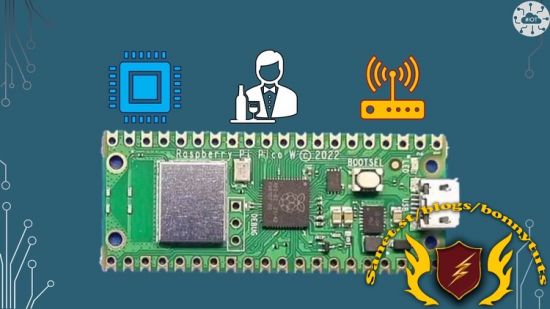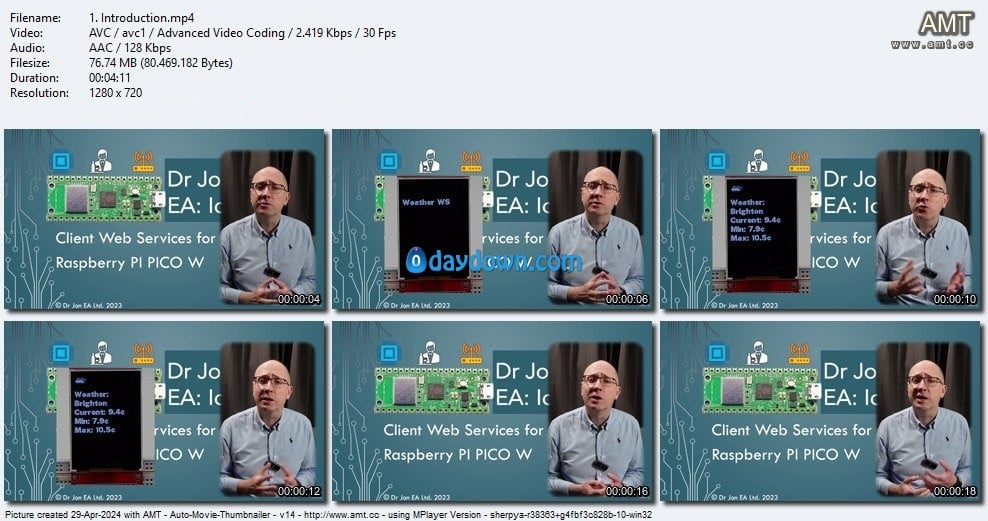
Published 4/2024
Created by Dr Jon Durrant
MP4 | Video: h264, 1280×720 | Audio: AAC, 44.1 KHz, 2 Ch
Genre: eLearning | Language: English | Duration: 63 Lectures ( 6h 4m ) | Size: 3.25 GB
Restful Web Services for the Raspberry Pi Pico W
What you’ll learn:
Understand Restful Web Services Concepts
Write Web Service clients on the Raspberry Pi Pico using LWIP
Write Web Service clients on the Raspberry Pi Pico using coreHTTP
Write Web Service servers on the Raspberry Pi Pico using LWIP
Write Web Service servers on the Raspberry Pi Pico using Socket based HTTPD
Requirements:
Able to work with the Raspberry Pi Pico SDK Toolchain
Able to programme in C/C++ on microcontroller
Awareness of computer networks (IP and Ethernet)
Able to install software and configure firewall on own laptop or desktop
Basic knowledge of Python which will be used for test clients and servers.
Description:
Using Web Services I can pull real-world data for my Raspberry PI Pico W to act on. Or submit sensor data from my Pico W to central services in an IoT pattern. Web Services enable us to connect the Pico W to a wider world of exciting distributed systems.In this course, we explore how to code C/C++ for a Pico-W to become a web service client. We look at two fundamental libraries to manage the HTTP protocol; LWIP HTTP App and coreHTTP. coreHTTP requires that we also use FreeRTOS kernel and LWIP Sockets. The library gives us a great deal of flexibility and with wolfSSL allows us to connect to HTTPS web services.The restful web services we primarily target on the course respond with JSON payloads. The course teaches how to parse these using two optional libraries coreJSON and tiny-JSON. Some web service payloads return XML and a further two libraries are explored to be able to handle these payloads.The course uses STDIO for the output of most web services. Two examples use a pre-built Pico-W display board, the PIMORONI Galactic Unicorn. One example uses a TFT screen, this will needs to be wired to the Pico W. Optionally you could modify these examples to produce STDIO or use alternative hardware.The course assumes knowledge of C++. Though each example walks through the functionality, the course will not talk about the syntax of C++. FreeRTOS Kernel is used to support concurrent tasks and enable POSIX Sockets. An understanding of FreeRTOS Kernel is assumed. I have another course on FreeRTOS Kernel for the Raspberry PI Pico to cover this.The course assumes you can compile and deploy C++ code to the Pico Q using the Raspberry PI Pico SDK. My other course “Introduction to C Development Environment for Raspberry PICO” teaches these skills.A web service test environment to support building and understanding these web services clients uses Python. Some Python knowledge would be helpful.
https://rg.to/file/4b62bbe1aa0b2a4c6e32559f3803e51e/Web_Service_Clients_on_Raspberry_Pi_Pico_W(C__).part1.rar.html
https://rg.to/file/9750e0aa71c32002f0b2c6b361501b1b/Web_Service_Clients_on_Raspberry_Pi_Pico_W(C__).part2.rar.html
https://rg.to/file/b2d692df24d5598d85216031fd890fe1/Web_Service_Clients_on_Raspberry_Pi_Pico_W(C__).part3.rar.html
https://rg.to/file/942724d6a3bb640dc607d50f4e799afb/Web_Service_Clients_on_Raspberry_Pi_Pico_W(C__).part4.rar.html
转载请注明:0daytown » Web Service Clients on Raspberry Pi Pico W(C++)
 Password/解压密码www.tbtos.com
Password/解压密码www.tbtos.com